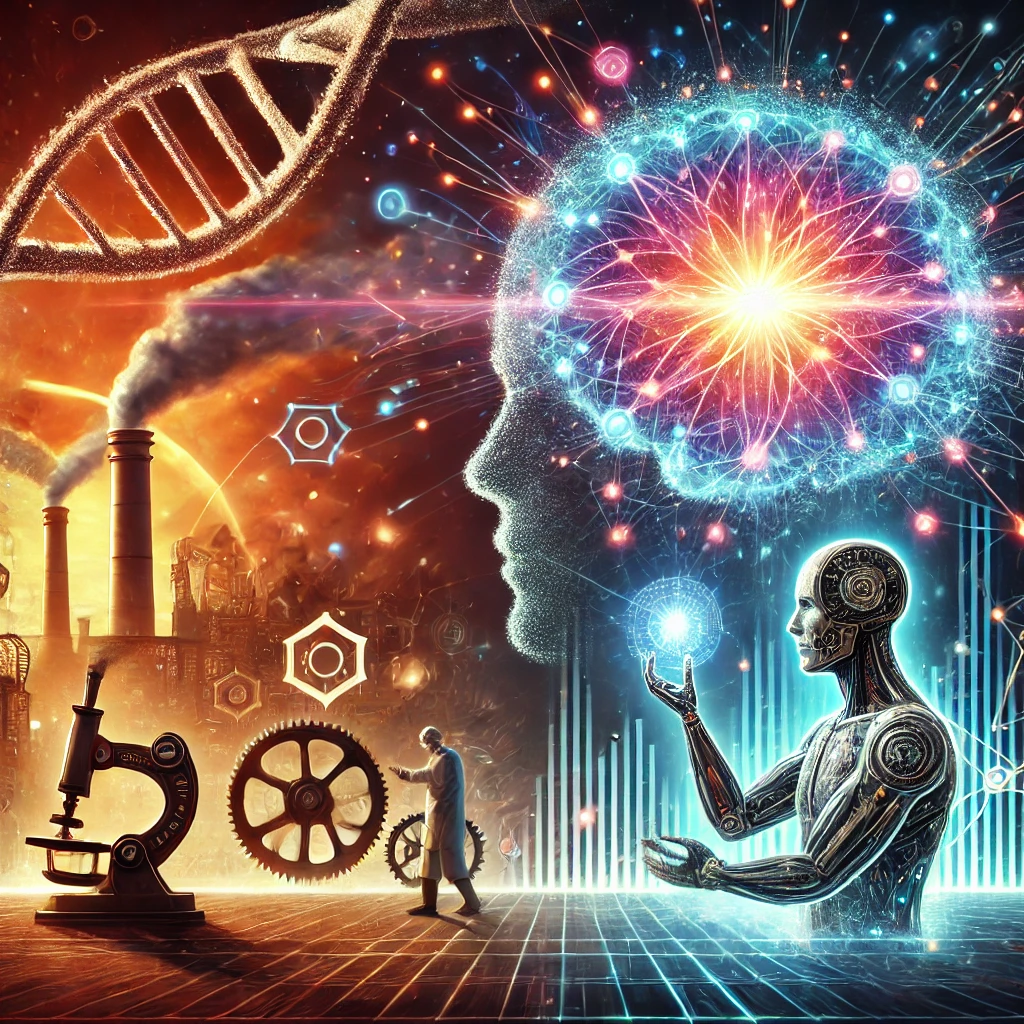From Human-Trained to Self-Learning: The Evolution of AI and Its Place in History
Artificial intelligence (AI) is no longer a distant concept of science fiction; it has arrived, reshaping the world in profound ways. Imagine a time when scientists, armed with little more than slide rules and early computers, toiled for years to decode mysteries like the structure of DNA or the vastness of space. Each breakthrough required countless hours of human effort and incremental progress, driven by determination but limited by the tools at hand. Now, picture a world where machines not only think faster than we ever could but teach themselves to solve challenges we didn’t even know existed. Imagine AlphaFold, an AI system developed by DeepMind, decoding protein structures—a task that once took scientists years—in a matter of hours. This breakthrough has revolutionized fields like drug discovery, exemplifying the transformative power of AI. This is the story of AI—a revolution that has accelerated beyond imagination, with implications that redefine how we think about intelligence, progress, and the future.
A Tale of Beginnings: The Human-Taught Machine
The story of artificial intelligence began simply enough, with machines designed to follow our instructions. The earliest AI systems, like IBM’s Deep Blue, operated under strict human oversight. They relied on rule-based logic and strategies meticulously programmed by experts. When Deep Blue defeated Garry Kasparov in 1997, it was hailed as a groundbreaking moment. But this victory, impressive as it was, belonged as much to the programmers behind the machine as it did to the technology itself.
These systems were limited. They could process what they were taught, following predefined rules and patterns, but they couldn’t innovate beyond the scope of human guidance. For example, a chess engine could calculate millions of possible moves to outplay an opponent but would fail to invent new strategies outside its programmed parameters. The machines of this era were tools—brilliant tools, but tools nonetheless.
The Leap Forward: Machines That Teach Themselves
The advent of deep learning marked a turning point in this tale. Machines began to evolve beyond human dependency, learning directly from data rather than relying on explicit programming. Consider AlphaGo, a system that didn’t just play the ancient game of Go—it mastered it. By studying millions of games and later teaching itself through self-play, AlphaGo discovered strategies that no human had ever conceived. It didn’t just replicate human knowledge; it transcended it.
This shift from human-trained to self-learning AI represents a profound transformation, comparable to the leap from hand tools to industrial machines during the Industrial Revolution. While hand tools amplified individual effort, industrial machines reshaped entire systems of production. Similarly, self-learning AI doesn’t just enhance human capabilities; it fundamentally redefines them, allowing machines to innovate and adapt independently. The machine was no longer just an extension of human effort. It became an autonomous entity, capable of learning, adapting, and improving on its own.
Reducing Years to Seconds
The speed at which AI operates is nothing short of astonishing. Imagine AlphaZero mastering chess, shogi, and Go—games that took humanity centuries to perfect—in a matter of hours, displaying creativity and strategies beyond human comprehension. Tasks that would take humans decades to accomplish are now completed in seconds. Imagine:
- Drug Discovery: Where once it took years of trial and error in labs, AI now simulates molecular interactions in minutes.
- Astronomy: Processing cosmic data that would overwhelm human researchers is done almost instantaneously.
- Language Models: Generating coherent, meaningful text in seconds, saving hours of human effort.
To understand this transformation, think back to the industrial revolution, when steam engines replaced horses. Just as horsepower became the standard for measuring mechanical strength, AI’s “infinite-like bandwidth” is redefining our benchmarks for intelligence. While not truly infinite, AI’s ability to process vast datasets in parallel and operate continuously creates a sense of limitless potential.
Moreover, the trajectory of AI development is exponential, not linear. Unlike previous technologies that progressed in steady, predictable steps, AI’s self-learning capabilities accelerate its growth. Each iteration builds on prior knowledge, creating a compounding effect that shortens development cycles and amplifies progress. This unique acceleration allows breakthroughs to emerge at an unprecedented pace, making the trajectory of AI unlike anything humanity has seen before. The gap between what humans and AI can achieve isn’t just growing—it’s accelerating.
The Rise of a New Intelligence
This exponential growth has given rise to a new kind of intelligence—one that redefines what it means to be “smart.” Self-learning AI now operates at a scale and speed that dwarfs human capabilities. It processes billions of inputs, uncovers patterns invisible to human eyes, and solves problems we didn’t even know existed.
Consider these implications:
- Infinite-Like Bandwidth: AI can analyze billions of data points simultaneously, a feat no human mind could achieve.
- Time Compression: Decades of learning condensed into days or hours.
- Unparalleled Scalability: AI systems operate continuously, free from the limitations of fatigue or time.
This is not just an enhancement of human capability; it’s a leap into a new era. For instance, AI is already revolutionizing healthcare by predicting patient outcomes with astonishing accuracy, and in the arts, it’s composing music and creating visual art that rivals human creativity. To grasp the implications is to understand that intelligence itself is being redefined. What was once the realm of human ingenuity is now shared with machines that think, learn, and innovate on their own.
AI in the Arc of History
To appreciate where we stand, it’s useful to look back:
- The Industrial Revolution replaced manual labor with machines, exponentially increasing productivity and reshaping economies.
- The Digital Revolution transformed how we communicate, connect, and process information, ushering in globalization.
- The AI Revolution goes even further, enabling machines to perceive, reason, and create. It marks a departure from mere augmentation to true innovation—a partnership between human and machine intelligence.
The New Frontier: Implications of Self-Learning AI
Self-learning AI is rewriting the rules of creativity, scalability, and discovery by intertwining these elements into a unified force for innovation. Creativity drives novel solutions that feed directly into scalability, allowing breakthroughs to reach global audiences rapidly. This scalability, in turn, accelerates discovery as data from vast implementations feed back into the AI’s learning loop, creating a self-reinforcing cycle of improvement and ingenuity.
- Creativity: AI’s ability to uncover solutions beyond human comprehension drives breakthroughs in science, art, and technology.
- Scalability: From personal assistants to global applications, AI’s reach is boundless.
- Ethics: With this power comes responsibility. How do we ensure AI remains a tool for good?
Just as the steam engine transformed economies and the internet redefined connectivity, AI is poised to become the defining technology of our era. But unlike its predecessors, it doesn’t just amplify human effort—it transcends it, pushing the boundaries of what’s possible.
Writing the Next Chapter
The journey of AI is far from over. As we move forward, AI faces pressing challenges such as ensuring ethical decision-making, mitigating biases in algorithms, and addressing concerns about job displacement. At the same time, the opportunities are boundless, from revolutionizing global healthcare systems to combating climate change with predictive models. These dualities define the next phase of this transformative journey. From its humble beginnings as a tool of calculation to its current state as a self-learning force, AI has redefined what it means to innovate. The challenge now is not just to harness this power but to guide it responsibly. This entails establishing ethical frameworks, ensuring transparency in AI decision-making, and prioritizing inclusivity in its development. For example, creating algorithms that are free from bias and accessible to diverse populations is crucial to maximizing AI’s benefits while minimizing potential harm. In doing so, we ensure that this new intelligence serves as a force for good, shaping a future that benefits all of humanity. And as we write the next chapter in this story, one thing is clear: the best is yet to come.

